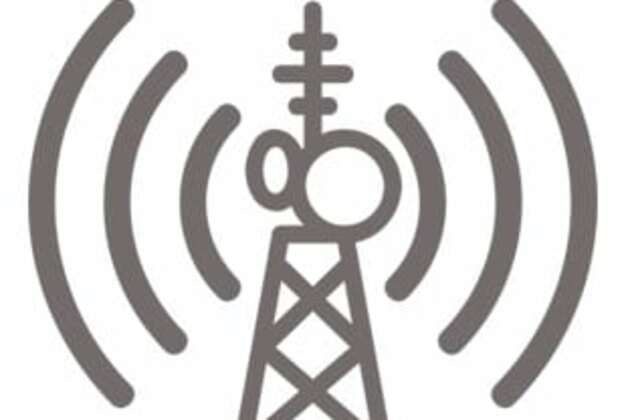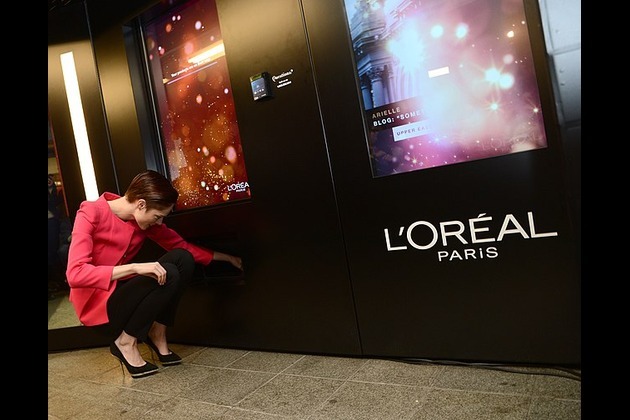Industrial Air Pollution in the US
7Newswire
04 May 2021, 14:12 GMT+10

ir pollution is one of the biggest killers across the world. Of course, no death certificate lists air pollution as the cause of death. According to the World Health Organization (WHO), 4.2 million deaths occur globally each year because of ambient air pollution exposure. Research also shows that ambient air pollution accounts for one out of every 25 premature deaths.
Besides health implications, air pollution has a devastating impact on the environment and local and global economies. Although air pollution can come from domestic sources, the single largest air pollution source is from industries, whether industrial facilities, oil refineries, power plants, or factories. Emissions from the construction industry are a close second.
It's easy to highlight the negative impacts of air pollution, and it's difficult to mitigate the impacts given that our economy is reliant on fossil fuels. When you take a look at the long-term trends, though, there is a silver lining. At least in the US.
Sulfur dioxide emissions, for example, peaked in North America alongside South America and Europe in the 1970s. Since the 1970s, there has been a steady decline in emissions for these regions of the world. Asia and Africa, meanwhile, have seen a growth in emissions.
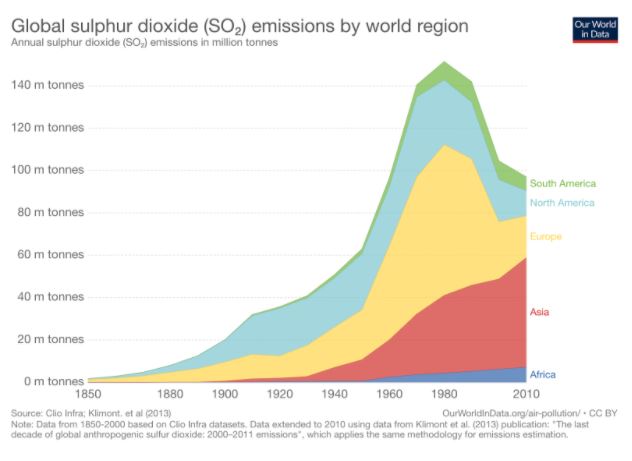
This article will take a closer look at industrial air pollution in the US, its impacts, and mitigation strategies. Before we get into that, though, let's consider what counts as air pollution.
What is Air Pollution?
The National Resources Defense Council describes air pollution as ' the release of pollutants into the air that is detrimental to human health and the planet as a whole.' Pollutants come in various forms and can be solid, liquid, or gaseous. The Environmental Protection Agency (EPA) places pollutants into six main categories, also known as 'criteria air pollutants.'
- Carbon monoxide
- Lead
- Nitrogen oxide
- Particle pollution (particulate matter)
- Sulfur oxides
- Ground-level ozone
Read more about the criteria pollutants here.
Other pollutants include synthetic vitreous fibers, polycyclic aromatic hydrocarbons (PAHS), benzene, asbestos, and creosote. Most of these pollutants come from industrial facilities such as mines, plants, manufacturing factories, and refineries.
What Are the Biggest Sources of Industrial Air Pollution
The main sources of toxic air pollution in the U.S. are from a limited number of industries. As you can see from the table below, electricity generation is the sector that accounts for the largest release of industrial air pollutants.
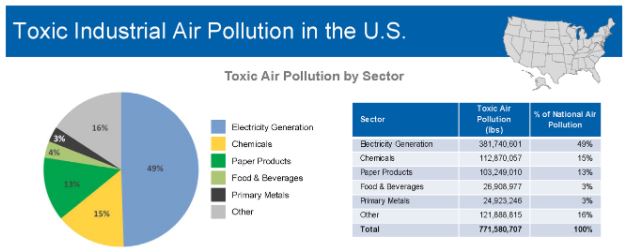
There are three primary sources of power generation in the U.S. They are nuclear energy, renewable energy, and fossil fuels. Natural gas accounted for 40% of the electricity generation capacity in the U.S in 2020. Coal power plants came in second, generating about 19% of the U.S. energy needs.
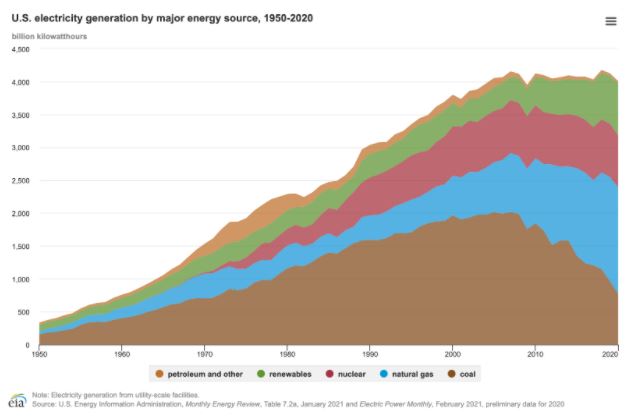
Toxic industrial pollutants are released by coal, petroleum, or natural gas power plants. Coal releases the most toxic pollutants during combustion out of all of the fossil fuels listed.
As you can see from the graph, natural gas has become increasingly important since 2010. A few coal-powered power plants have been adapted to natural gas, speeding up this transition. That is good overall when it comes to reducing industrial emissions.
Effects on Humans & The Environment
The medical conditions resulting from air pollution can result in short-term and long-term conditions. Many of the health implications from environmental air pollution are respiratory. Examples of short-term conditions resulting from air pollution include coughs, nausea, dizziness, headaches, and skin irritations.
Longer-term health implications of air pollution can include emphysema, lung cancer, and strokes. Ambient air pollution can also worsen existing conditions such as asthma, skin cancer, preterm births, dementia, and autism.
The reactions of people to air pollution differ based on many factors. Age, for instance, plays a crucial role. Children and older adults are more susceptible to diseases caused by air pollution. People with existing conditions and weak immune systems are also more vulnerable.
Air pollution not only wreaks havoc on people but also has a devastating effect on the environment. Air pollution's main environmental effects include acid rain, smog, ozone depletion, eutrophication, and global warming.
Industrial Air Pollution Mitigation Strategies
Industrial air pollution has a devastating effect on humans and the environment. Starting with the Clean Air Act in 1963, the US government has enacted laws and regulations focused on controlling and reducing industrial emissions.
Industries and factories that do not comply with the emission standards can face criminal and financial penalties. The strict legislation is there to ensure that factories and power plants meet compliance standards.
Companies that emit air pollutants should ensure they are using the best available techniques for air pollution mitigation. These can include using flue gas desulphurization scrubbers to clean the gases passing through a smokestack before release, for example.
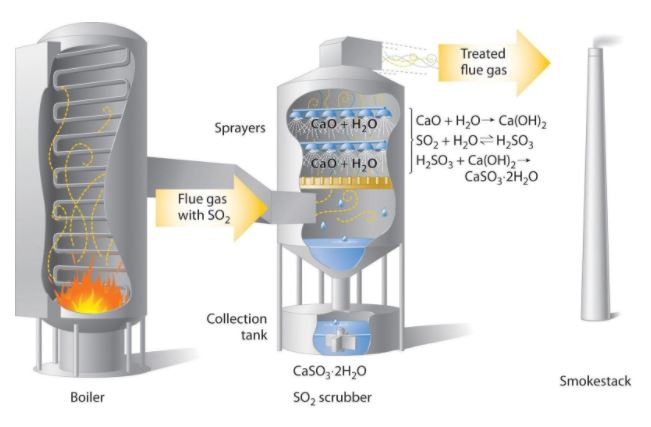
Companies that emit air pollution also need to monitor emissions to ensure they meet the necessary regulatory standards. Monitoring can involve continuous emissions monitoring systems, continuous opacity monitoring, compliance stack flow monitoring, process monitoring, and tunnel monitoring.
Sustainability and energy efficiency should be the priority of all companies. Energy efficiency is particularly important for manufacturing companies that require a lot of energy to operate. The method for improving energy efficiency will depend on your operations. Common solutions for improving energy efficiency involve upgrading and retrofitting equipment and operating outside of peak energy times.
 Share
Share
 Tweet
Tweet
 Share
Share
 Flip
Flip
 Email
Email
Watch latest videos
Subscribe and Follow
Get a daily dose of London Mercury news through our daily email, its complimentary and keeps you fully up to date with world and business news as well.
News RELEASES
Publish news of your business, community or sports group, personnel appointments, major event and more by submitting a news release to London Mercury.
More InformationUK Editorials
SectionOperations back to normal after multiple Canadian airports hit with bomb threats
Operations back to normal after multiple Canadian airports hit with bomb threats
Five to watch on Scotland's summer tour of the Pacific
Five to watch on Scotland's summer tour of the Pacific
John Kear- Long-serving head coach leaves Wales rugby league post
John Kear- Long-serving head coach leaves Wales rugby league post
RE Park City puts a new twist in growing consignment market - Park Record
RE Park City puts a new twist in growing consignment market - Park Record
Tuske To Take On Ownership Of Alabama Radio Properties
Tuske To Take On Ownership Of Alabama Radio Properties
EFC, Skandha Team To Boost MCC Infrastructure, Services
EFC, Skandha Team To Boost MCC Infrastructure, Services
Business
SectionStandard and Poor's 500 and and Nasdaq Composite close at record highs
NEW YORK, New York -U.S. stock markets closed with broad gains on Thursday, led by strong performances in U.S. tech stocks, while European...
Persson family steps up H&M share purchases, sparks buyout talk
LONDON/STOCKHOLM: The Persson family is ramping up its investment in the H&M fashion empire, fueling renewed speculation about a potential...
L'Oreal to buy Color Wow, boosts premium haircare portfolio
PARIS, France: L'Oréal is making a fresh play in the booming premium haircare segment with a new acquisition. The French beauty conglomerate...
Robinhood launches stock tokens for EU investors, adds OpenAI
MENLO PARK, California: Robinhood is giving European investors a new way to tap into America's most prominent tech names — without...
Wall Street diverges, but techs advance Wednesday
NEW YORK, New York - U.S. stocks diverged on Wednesday for the second day in a row. The Standard and Poor's 500 hit a new all-time...
Greenback slides amid tax bill fears, trade deal uncertainty
NEW YORK CITY, New York: The U.S. dollar continues to lose ground, weighed down by growing concerns over Washington's fiscal outlook...





